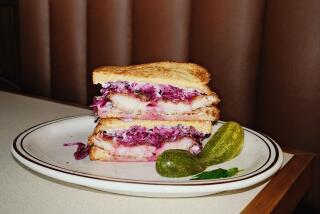The Unkindest Cut of All: Bloody Mis-slicing of Bagel : Health: Growing popularity of the Jewish import is producing a spate of weekend wounds by klutzes.
- Share via
WASHINGTON — Every weekend, they arrive at hospital emergency rooms with blood dripping from their injuries: upstanding citizens, often leaders in their fields, sometimes with their pajamas showing beneath their coats.
It happened one recent Saturday morning to Eric Berman, head of research for the Democratic National Committee. He tried to hide his wound, wrapping it in a red kitchen towel. But when his face turned ashen, his mother-in-law shoved him into a cab and took him to George Washington University Medical Center.
“When I pulled off the towel, the doctor said, ‘Oh, a bagel injury.’ He knew immediately,” Berman said of the cut he suffered while slicing his breakfast. How could the doctor conclude that about a patient he’d never seen before?
“Oh, we get a bunch of these every Saturday morning,” Berman said the doctor told him.
An informal survey of area hospitals revealed that bagel-related accidents are, in the words of Mark Smith, head of George Washington’s Department of Emergency Medicine, “the great underreported injury of our times. I wish I had statistics, but I can say it’s unbelievable how many there are.”
An epidemiologist tracing the surge in bagel accidents no doubt could find its roots in an explosion of bagel consumption and franchises, with national sales approaching $1 billion a year. In the Washington area, for example, Chesapeake Bagel Bakery started with one store on Capitol Hill in 1981 and now has 35 in the Washington area, 60 nationwide and 361 more in development.
Spokesman Dan Rowe said Chesapeake sells 700,000 bagels a week in this area alone. Its major competitors include Whatsa Bagel, Bethesda Bagel and Bruegger’s Bagel Co., which entered the local market a year ago and now has eight stores, not to mention independent bakeries and the bagels and bagel look-alikes sold in grocery stores.
With all those slippery bagels being sliced by recent converts to the once-humble dough brought to America by Jewish immigrants at the turn of the century, accidents were inevitable. There is even a Yiddish word to describe a person who cuts himself while cutting bagels: klutz.
“The bagel is inherently unstable because it’s round,” said Smith, of George Washington Medical Center. “In fact there are two unstable surfaces: the knife against the bagel and the bagel against the table.”
That inherent instability is exacerbated by the firm, fight-back crust around a softer middle. “This is speculation, but I theorize that it’s difficult to modulate the force needed to get through the exterior once you hit the doughy part, and you cut your finger,” Smith said.
A spokeswoman for Georgetown University Medical Center, misunderstanding a voice-mail message, returned a reporter’s call prepared to discuss fatal injuries. Informed of the real query, she changed course without missing a beat.
“Oh, bagel injuries,” Claire Fiori said. “Oh, yes; that’s one of our biggest.”
She summoned Thomas Stair, head of the emergency medical department, who said bagel accidents are a “recognizable syndrome. . . . There should be a name for it. It’s a good opportunity for an eponym: Somebody should write a paper and get it named after themselves.”
There is one bright spot for hospitals: Nearly every bagel victim is insured. As trauma technologist Rick Tuppen put it, bagel cuts are “the bane of the middle class.” This ethnic import from Eastern Europe has acquired a certain cachet associated with urbanity, upward mobility, East-Coastness, even effeteness.
“I’m so embarrassed about my cut,” Berman said. “My populist reputation is shot.”
More to Read
Sign up for Essential California
The most important California stories and recommendations in your inbox every morning.
You may occasionally receive promotional content from the Los Angeles Times.













